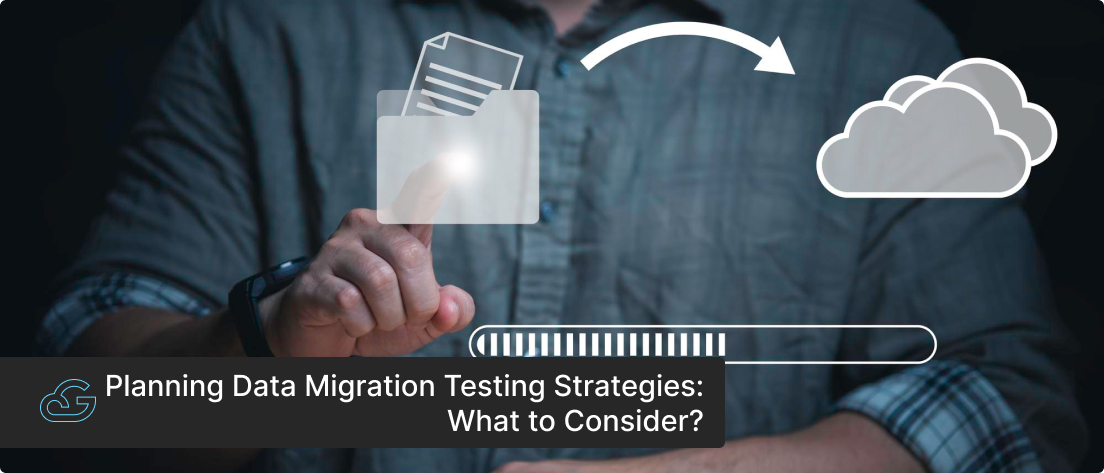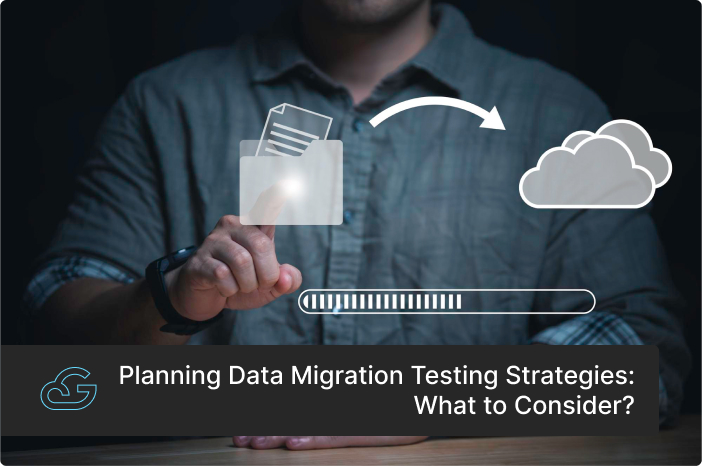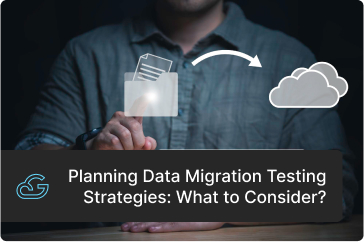Blogs / Cloud Migration
Planning Data Migration Testing Strategies: What to Consider?
By
Harish K K
Posted: December 23, 2024
• 7 minutes
Data migration is a decisive part of any system upgrade, cloud adoption, or modernization initiative. Even though every business today runs behind cloudification, studies show that more than half of migration projects fail. The complexities of migrating data from on-premises systems to new cloud environments are major contributors to these failures. A failed data migration can seriously affect any business. Problems like missing information, incorrect details, or poor-quality data can disrupt operations and cause unnecessary stress. These issues become even more significant when dealing with large-scale data migration.
Certainly, the common errors should be nailed down during the migration testing process. Careful planning, thorough validation, and proper verification at every stage of the migration are important to ensure your data is accurate, consistent, and complete. But here’s the catch - if your testing team isn’t familiar with the right migration testing practices, strategies, or processes, things can quickly go off track. To help you get it right, we’ve put together a simple guide to create an effective data migration testing strategy.
What is Data Migration Testing?
Data migration testing is the process of verifying data before and after migration. The testing ensures data is correctly moved from the source to the target system without any loss, performance problems, or disruption to business operations. It ensures that the data in the new system is accurate, complete, and matches the original data. Moreover, you can confirm that the new system works smoothly with the migrated data and meets all functional and non-functional requirements. This helps to prevent problems like incorrect data, system crashes, or missed business goals in the migration process.
Benefits of Data Migration Testing for Businesses
Data migration testing is a vital component of your cloud transformation strategy that enables cloud operational excellence and strategic decision-making. Explore the key benefits of data migration testing and how it contributes to successful cloud migration for your business.
- Data Integrity Assurance: Data migration testing ensures that the data transferred to the cloud remains consistent, accurate, and complete, preventing any loss or corruption during the process. This is critical for businesses that rely on data-driven decision-making.
- System Compatibility Verification: Data migration testing ensures that both legacy systems and the new cloud environment are compatible, allowing for seamless integration and preventing issues related to software incompatibilities.
- Improved Security: Testing the migration process helps identify and address any security vulnerabilities in the cloud environment, ensuring that sensitive data is protected from unauthorized access and breaches throughout the migration process.
- Enhanced Performance: By validating that the cloud environment meets performance expectations, businesses can ensure that applications will run efficiently post-migration, helping to avoid slowdowns and enhance user experience.
- Cost Efficiency: Early detection of migration issues reduces the risk of costly disruptions or the need for expensive post-migration fixes, making the entire process more cost-effective for businesses.
- Regulatory Compliance Assurance: Data migration testing ensures that the business maintains compliance with industry regulations and standards, especially when it comes to sensitive data handling and storage in the cloud.
- Faster and Smoother Migration: Testing the data migration process in advance allows for smoother execution, accelerating the overall migration timeline and minimizing delays that could impact business operations.
When Should You Perform Data Migration Testing?
It is always essential to conduct migration testing whenever data is moved, changed, or integrated into a new system. During such transitions, the testing team typically conducts thorough testing, through which all the possible issues are resolved as they arise, ensuring the migration goes smoothly as expected. The goal is to make sure that data integrity, functionality, and compliance are maintained before, during, and after the migration. Below are some key scenarios where data migration testing is required:
Key Phases Involved in Data Migration Testing
Data migration testing involves a series of steps that include action plans to detect and address any issues that arise during and after the migration process. It’s a complex process that needs a lot of preparation – such as planning, data backups, quality testing, quality assurance, and validation of results. The primary phases of data migration testing are as follows:
-
Pre-Migration Testing:
- Verifying the source data for completeness and quality.
- Identifying system requirements and any dependencies.
- Mapping data fields between the source and target systems.
- Assessing potential compatibility issues between systems.
- Developing a migration test plan and ensuring the necessary tools and resources are set to use.
-
Migration Testing:
- Verify data accuracy, completeness, and integrity in the target system.
- Check migration performance to minimize downtime and prevent data loss or corruption.
- Test key features and functionalities in the new system.
-
Post-Migration Testing:
- Verifying that all data has been transferred and is intact, with no loss or corruption.
- Validating end-to-end system behavior and integration with the migrated data.
- Conducting user acceptance testing (UAT) to ensure that the system meets user expectations.
- Checking the target system’s performance, ensuring that it operates at or better than the legacy system.
- Ensuring the system can be rolled back to its original state without disruptions in case of migration failure.
Pre-migration testing is performed before the actual migration begins. This phase involves preparing the legacy system, defining the migration strategy, and ensuring that the system is ready for migration.
Activities in Pre-Migration Testing:
This phase takes place during the actual migration process. It focuses on validating that the data is being transferred correctly and that the target system functions as expected with the newly migrated data.
Activities in Migration Testing:
Post-migration testing is performed after the migration has been completed. This phase is essential to ensure that the migration process is successful and that the data is accessible, accurate, and functional in the new environment.
Activities in Post-Migration Testing:
Best Practices for Building Effective Migration Testing Strategies
Without a solid testing strategy, even the best migration plans can falter. A well-crafted approach to testing is necessary to find the hidden risks and resolve issues at every phase of migration. Below are some testing strategies you must follow to ensure a flawless migration.
-
Perform Comprehensive Data Assessment:
-
Develop an Organized Test Plan:
-
Use Sample Data for Initial Testing:
-
Execute Incremental Testing in Phases:
- Start with unit testing to validate individual components or data sets.
- Next, perform system testing to ensure the integrity of the entire system.
- Finally, conduct user acceptance testing (UAT) to confirm that the migrated data meets business requirements.
-
Validate Data Accuracy and Integrity After Migration:
-
Automate Testing Where Possible:
A comprehensive assessment of source data allows you to identify potential issues such as missing values, duplicates, or data quality inconsistencies that could disrupt the migration. It also highlights dependencies and relationships within the data, which are vital to maintaining its integrity in the new system. You can document these findings later to create a solid reference for designing relevant and targeted test cases.
A well-structured test plan outlines the scope of testing, defines key milestones, and specifies the roles of team members involved. The test plan must also include detailed test cases and expected results. Make sure that all scenarios, from basic data validation to complex system integrations, are covered. By having a clear and well-documented plan, you can minimize the risk of overlooking critical errors and ensure the migration progresses in a systematic and controlled manner.
Early validation builds confidence for the later stages of migration. Instead of working with the entire data set, start with small, representative samples. Testing with a subset of the data allows you to identify probable issues early and refine migration processes without risking the full data set. This approach minimizes risk, saves time, and ensures that the migration scripts and procedures are ready before scaling to the complete data set.
Data migration testing should be executed in phases to isolate and address issues systematically. Phased testing helps to track progress and allows for prompt resolution of errors before they escalate.
Once the data is fully migrated, perform rigorous validation to ensure its accuracy and integrity. This involves comparing data in the source and target systems, checking for any inconsistencies, and verifying that all dependencies and relationships remain intact. Accurate data indicates that the migration was successful and the new system is fully functional and ready for use.
Using automation tools in your testing process can make things faster and easier. Automation allows you to handle large amounts of data quickly and reduces the chances of mistakes caused by human error. By automating repetitive tasks like data comparisons or validation checks, your team can spend more time focusing on solving complex problems. This not only saves time but also improves the overall efficiency of the testing process.
You Might Like: Best Cloud Migration Tools and Services to Choose for 2025
Understanding the Main Challenges in Data Migration Testing
Testing the data migration comes with its own set of challenges, like managing large amounts of data, ensuring compatibility between old and new systems, and working within tight timelines. With the right planning, these challenges can be tackled effectively. Let’s be aware of the common hurdles the testing teams face during data migration testing and the practical solutions to overcome them.
-
Risk of Data Loss:
-
Extended Downtime and Disruptions:
-
Poor Data Quality:
-
Data Mismatch Issues:
-
Lack of Data Governance:
-
Managing Large Data Volumes:
Whether due to errors, system crashes, or script failures, losing important data during migration can have serious consequences. To prevent data loss, ensure that a complete backup is made before migration begins. This allows for quick data recovery and minimizes disruption to business operations.
Extended downtime during migration testing can disrupt your business, leading to revenue losses and unhappy customers. To avoid such negative outcomes, plan testing during off-peak hours or weekends when the system is used less. This minimizes disruptions to your operations and keeps your business running smoothly throughout the migration process.
Poor data quality, including duplicated, outdated information, or inconsistent formats, are the major challenges that can complicate your data migration process. These issues can be resolved by prioritizing data cleaning and validation before migration. Migration testing ensures that only high-quality data is transferred and all the data errors are identified and corrected simultaneously.
Data mismatch occurs when the data in the source system doesn’t align with the structure, format, or types in the target system. To prevent this, conduct thorough data mapping and conversion before migration. This ensures that all data fits correctly in the new system, reducing the risk of errors post-migration.
Improper handling of data during migration can lead to security breaches, unauthorized access, or data corruption. Lack of proper governance can put your organization at risk. By setting clear roles and responsibilities, you can establish accountability during the migration process. Enforcing data security policies and adhering to compliance standards further ensures that sensitive information is protected throughout the migration.
Migrating and testing large datasets can be time-consuming and resource-intensive. This often results in delays and increased costs for the project. To resolve this challenge, you can leverage automation tools that can efficiently handle large volumes of data, speeding up the process.
Why Choose Gsoft for Your Data Migration Needs?
Data migration is a critical process for every business today as it grants them so many benefits over their competitors. Yet, the process is complex and requires the right expertise, tools, and strategies for successful implementation. At Gsoft, we help you use the right strategies and tools at the right time and to avoid typical mistakes. Check what sets us as the best fit to manage your data migration project.
- Cloud Migration Expertise: Top-notch cloud migration expertise to handle even the most complicated data migrations to ensure a smooth process with minimal disruptions.
- Access to Latest Migration Technologies: We use top advanced Tools and Technology to ensure your data is migrated accurately and works perfectly in the new system.
- Customizable Migration Solutions: With customized solutions for businesses of all sizes, we meet the unique needs of your business and add value to your project.
- Thorough Testing for Accuracy: We run detailed tests to check every part of the migration, making sure your data is accurate, consistent, and fully operational.
- Security and Compliance Assurance: We follow thorough security rules and compliance standards to keep your data safe throughout the migration process.
- Precise Consistency Validation: With smart validation tools, we carefully check dashboards, databases, and applications to make sure everything stays consistent and reliable.
Contact our cloud migration experts to understand how Gsoft can help your business create a well-defined cloud migration testing strategy for a stress-free cloud transition.


Get Know More About Our Services and Products
Reach to us if you have any queries on any of our products or Services.










